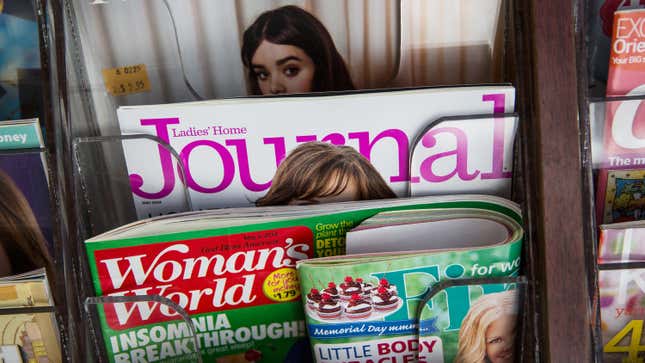Women's Media Is Thinning and We're Worse Off For It
Latest

In January 2017, The Establishment offered readers a deal. For $125, anyone could “sponsor” an essay on the small-but-mighty feminist website, and directly contribute to the kind of thoughtful, progressive writing that The Establishment published. ($125 was the website’s standard rate for features; $500 paid for more robust, long-form reported pieces.) Sponsoring didn’t give readers any editorial control, but “by participating in the program,” the editors wrote, “you’ll gain tangible proof of how you’ve contributed to improving our world” and funding the kind of small-scale corner of the internet that gave writers room to be smart and weird.
It didn’t work. On Monday, April 15, The Establishment announced it was publishing its “very last article.” The news, while disappointing, is not surprising. So-called women’s media seems particularly vulnerable as both print and digital struggle to find pathways for reliable revenue. For a long time, women’s media did this well: garnering advertising dollars by delivering a mix of make-up, fashion, dating, sex, and/or parenting advice with an authoritative, accessible tone. But in the last few years, editors and writers have struggled to find audiences—or at least, to find audiences big enough to make advertisers happy.
This instability has been well-documented. Since 2014, Ladies’ Home Journal and Lucky have both closed; Glamour, Teen Vogue, Redbook, and Self have ceased printing physical issues and gone digital-only, and Seventeen now only prints “special issues.” In the last five years or so, the staffs at women’s magazines—including Cosmo, Elle, W, and Women’s Health—have endured layoffs, lost resources, and now face precarious futures. In 2016, Hearst Media consolidated the fashion and beauty departments for five women’s brands at the company, and in 2018, it was reported that Condé Nast was considering selling off three titles, including Brides and W.
In 2018, The Hairpin, Rookie, and Lenny Letter all closed, and in 2016, AfterEllen was relaunched, abandoning the singular voice and perspective it cultivated for 14 years. The Frisky has been through multiple owners, and last year, its archive disappeared from the internet. Its current iteration reads as though its content was generated by bots. (A recent post headlined “5 Problems Transgender Face” includes the line: “So Trans people can transition a lot more smooth hormones, in our opinion hormones, make any transitions a lot easier it is another step, it is that next step is that you are on no hormones we are fully on testosterone.”)
When these sites shutter, we aren’t just losing a better future for writing; increasingly, we also lose the past. Hyperlinks expire, domain names lapse, and left unattended, archives can disappear overnight. xoJane, notable for its first-person essays, stopped publishing in 2016 after it was bought by Time Inc. (which itself was acquired by the Meredith Corporation in 2017). Sometime last October, former writers noticed that there is no longer a permanent archive of their work online. The xoJane URL now redirects to HelloGiggles, a website co-founded by Zooey Deschanel in 2011, and billed as “A Positive Community for Women.” (It was also bought by Time Inc. in 2015.) Perhaps fearing this, The Establishment has backed up its archive on Medium.
Like its predecessors, these publications were always interested in reporting on politics, as well as broader social and cultural issues that profoundly impact women’s lives. Glamour beefed up its coverage of women and candidates leading up to the 2016 election and in 2017, Cosmo published a guide to running for office that won a National Magazine Award. “It now seems patronizing to say that we’re only interested in shopping and fashion and lipstick,” Joanna Coles, former Cosmo editor-in-chief, told the Columbia Journalism Review in 2016.
-

-

-

-

-

-

-

-

-

-

-

-

-

-

-

-

-

-

-

-

-

-

-

-

-

-

-

-

-

-

-

-

-

-

-

-

-

-

-

-








































